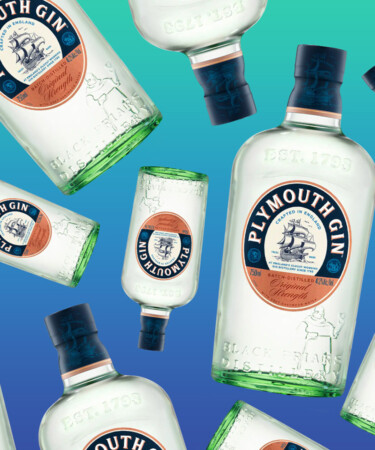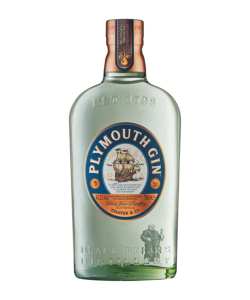With every batch distilled down the road from the town harbor, Plymouth Gin has captured the essence of the sea and England’s historic love for the spirit for hundreds of years. Founded in the late 1700s, the English brand has grown to be beloved among naval officers, the political elite, and even famous bartender Harry Craddock himself. While practically ubiquitous behind the bars of some of your favorite mixologists, the story of Plymouth Gin spans many centuries, names, and even bottle redesigns. Now that you know the basics, here are 10 more things you should know about the iconic gin brand.
Plymouth Gin is produced at the Black Friars Distillery, which has been standing since 1431.
The historic brand is produced in an even more historic building. Each batch of Plymouth is distilled in the Black Friars building, which dates back to the early 1400s and was once home to the Black Friar monks of the Dominican order prior to King Henry VIII’s dissolution of all English monasteries in 1536. The space then served as a debtors’ prison, the Plymouth’s meeting hall, and a refuge center for Huguenots fleeing France. Uncovered records even point to the existence of a malt house on the grounds dating back to 1697. Eventually, the building was made into a distillery, and was aptly named the Black Friars Distillery. Gin production began on-site in 1793, and today, the Black Friars Distillery is protected as a national monument. Those visiting the distillery are welcome to enjoy a drink in the building’s Refectory Room, which dates back to 1431 and is the oldest and most intact section of the distillery.
The gin was originally sold under a different name.
Prior to being named for the town it originates from, Plymouth Gin was sold as Coates & Co. Gin, named after the Coates Family, who joined the distilling operation Fox & Williamson at the Black Friars Distillery, eventually acquiring the entire space. Though production has always remained exclusive to the Black Friars Distillery, Coates & Co. was sold to various parent companies including Seager Evan, Whitbread— a now-defunct English brewer — and Allied Domecq, all of which allowed the producer to maintain the Coates & Co. name. It wasn’t until 2004 when the label was sold to Vin & Spirit — known for producing Absolut Vodka — that the name was changed to Plymouth Gin. In 2008, both Absolut and Plymouth Gin were sold to spirits giant Pernod Ricard, which still has both brands under its umbrella to this day.
The distillery is the oldest functional gin distillery in all of England.
Since 1793, the exact same recipe has been used at the distillery to create every bottle of Plymouth Original Gin, which includes botanicals like juniper, coriander, sweet orange, cardamom, angelica, and orris root. In subsequent years, a number of gin-producing hubs emerged in England beyond Plymouth, including London, Bristol, Norwich, and Wilmington. While the London Dry style was beloved in terms of flavor profile with its citrus and juniper-forward notes, Plymouth Gin set itself apart by producing a gin with a higher concentration of root botanicals, lending itself to a less dry and more earthy-flavored spirit.
Plymouth Gin was of the utmost importance for the British Royal Navy.
The gin’s production location proved to be more than a place of convenience as the spirit quickly became a favorite of the British Royal Navy, which stocked up on the product every time its boats anchored in Plymouth Sound. While traveling from harbor to harbor, Navy sailors tasted a number of gins, and Plymouth proved to be one of the favorites among them. In the 18th and 19th centuries, it was also widely believed that gin could assist in the treatment and prevention of numerous illnesses including scurvy and malaria. Soon enough, the British Royal Navy demanded that a certain amount of gin was to be present on every ship in the fleet for officers to enjoy and use to treat their ailments. By 1850, it is estimated that the Navy was purchasing over 1,000 barrels of gin for naval officers, and newly commissioned ships were all provided with a gin commissioning kit that included two bottles of Navy Strength Plymouth gin and glassware.
Once upon a time, Plymouth Gin was both a brand and a geographically protected region.
The term “Plymouth gin” is often used to identify the brand, but also a specific style of gin production. Following the popularity of Plymouth aboard naval ships, a number of gin distilleries across the country took to producing gins following a similar recipe, and distilled using higher amounts of root botanicals to mimic the taste and style of Plymouth. Likely believing an increase in production of Plymouth-style gins would threaten their sales to the British Royal Navy, the brand pursued a regional designation mandating that in order to be labeled “Plymouth Gin,” the gin must actually be produced in Plymouth, Devon.
In 2014, current owner Pernod Ricard declared that it no longer had the intention of renewing Plymouth Gin’s geographic designation. Under legislation put forth by the European Union, all products protected under a designation of origin must disclose “a description of the drink including the principal physical, chemical, and/or organoleptic characteristics of the product,” in addition to a description of the methods used to produce said product. As such, Plymouth Gin would have to disclose its recipe, which has been under lock and key since production began. Even though the product is no longer protected under a regional designation, Plymouth Gin remains the only brand producing in the Plymouth style.
That ship on the label isn’t any old boat.
Prior to the development of the Black Friars Distillery, the building served as a meeting hall for the town of Plymouth, and the close proximity of the building to the sea made it a convenient meeting point for 17th- century pilgrims boarding the Mayflower to the Americas. On Sept. 16, 1620, after spending their final night in England inside the Black Friars building, the pilgrims took a short walk to the harbor where they boarded the ship and set sail for the New World, where they would eventually start the Plymouth Colony on the same land we now call Massachusetts. Today, Plymouth Gin pays homage to the brave venturers with an image of the Mayflower front and center on every bottle produced.
Plymouth Gin was known and loved by a number of notable historical figures.
Following the popularity of Plymouth Gin among naval officers, the spirit quickly took off among a number of elites, including Winston Churchill, Franklin D. Roosevelt, Ian Fleming, and Alfred Hitchcock. In Harry Craddock’s iconic “The Savoy Cocktail Book,” each of the 23 gin cocktails featured specify the use of Plymouth Gin. Thanks to Plymouth’s favor among those with influence, the spirit’s popularity boomed even further.
You can enjoy one of five gins produced by Plymouth.
In addition to Plymouth Original Gin, which is bottled at 41.2 percent ABV, gin lovers are also welcome to try Plymouth Gin Navy Strength. It’s formulated at 57 percent ABV to mimic the gin once stocked on Navy ships, as it was high proof enough to prevent damaging the gunpowder it was often stored with. The brand also produces Plymouth Sloe Gin, which is around 26 percent ABV, and Plymouth Fruit Cup, which has been described as similar to Pimm’s and sits at 30 percent ABV. While it may be challenging to find, Plymouth also produces Mr King’s 1842 gin, which is made with two botanicals exclusively — hand-picked juniper from a singular mountain in Frontignano, Italy, and orris root. Only one batch was ever produced, amounting to about 2,000 cases of the limited-edition liquor.
The bottle of Plymouth you can buy today has undergone several redesigns.
When sold under the Coates & Co. name, Plymouth Gin’s original bottle was tall and slender, with a rounded neck. An image of a monk was depicted on the label, paying homage to the Black Friars who once resided exactly where the gin is produced. In the early 2000s, the bottle was redesigned for the first time in an Art Deco style to reflect the popularity the spirit had in the 1920s and ’30s. In 2012, the Chivas Brothers of Pernod Ricard hired brand design company Design Bridge to reimagine Plymouth’s bottle and refocus the packaging around the brand’s expansive history.
The new design was heavily inspired by the Black Friars Distillery, and replaces the angular edges of the Art Deco iteration with a more squat, hammered look that’s meant to mimic the appearance of a bottle that’s been weathered over time. According to Design Bridge team member Richard Baird, the uneven glass design is meant to look as if the bottle fell out of a sailor’s pocket. Additionally, the bottle’s clear glass was replaced with sea-foam green glass to reflect the distillery’s proximity to the sea and its history with the British Royal Navy. The label was also reimagined to be more in line with the original bottle’s label: Its monk was replaced by an image of the Mayflower, but he can still be found etched in the glass on the bottom right corner of every bottle.
At Black Friars Distillery, sustainability is key.
Outside of making a name for itself as the only gin distillery in Plymouth, the brand has also championed sustainability efforts in distilling. In addition to handcrafting and batch-distilling each batch of Plymouth, the distillery also uses 100 percent renewable electricity to power distilling operations and recycles all used botanicals to be made into energy using an anaerobic digestion power plant. In 2021, the brand announced its partnership with the Ocean Conservation Trust (OCT), a global ocean conservation nonprofit, in order to raise awareness regarding the importance of healthy marine life. With every bottle of Plymouth Gin sold, one British pound (GBP) is donated to OCT in order to support the regeneration of seagrass, and employees at the distillery are reported to often assist with local beach cleanups. Plymouth also redesigned its bottle once again by eliminating all single-use plastic used when bottling and reducing the weight of each bottle by 15 percent in an attempt to reduce carbon emissions by 60 tonnes — just over 66 standard tons — per year.

